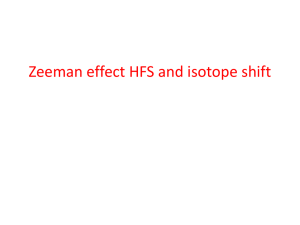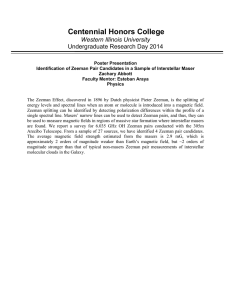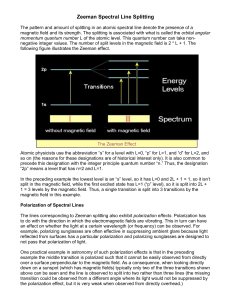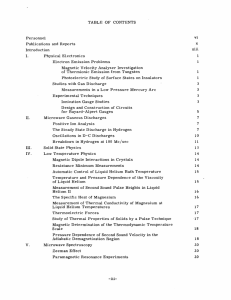Zeeman Effect - University of Missouri
advertisement
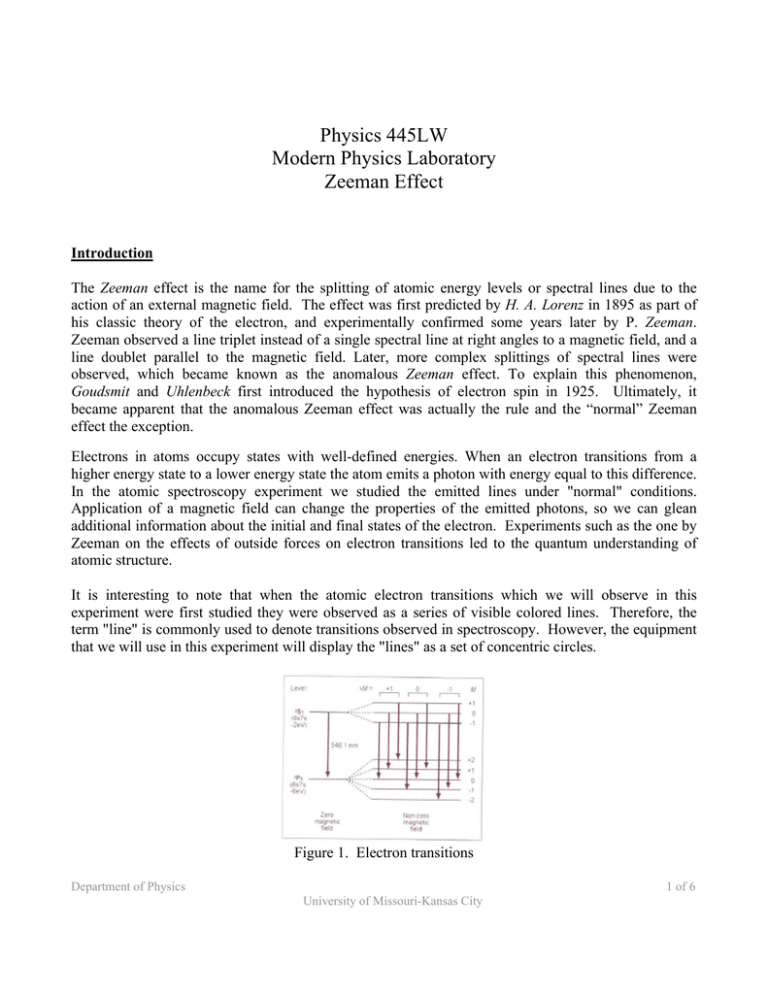
Physics 445LW
Modern Physics Laboratory
Zeeman Effect
Introduction
The Zeeman effect is the name for the splitting of atomic energy levels or spectral lines due to the
action of an external magnetic field. The effect was first predicted by H. A. Lorenz in 1895 as part of
his classic theory of the electron, and experimentally confirmed some years later by P. Zeeman.
Zeeman observed a line triplet instead of a single spectral line at right angles to a magnetic field, and a
line doublet parallel to the magnetic field. Later, more complex splittings of spectral lines were
observed, which became known as the anomalous Zeeman effect. To explain this phenomenon,
Goudsmit and Uhlenbeck first introduced the hypothesis of electron spin in 1925. Ultimately, it
became apparent that the anomalous Zeeman effect was actually the rule and the “normal” Zeeman
effect the exception.
Electrons in atoms occupy states with well-defined energies. When an electron transitions from a
higher energy state to a lower energy state the atom emits a photon with energy equal to this difference.
In the atomic spectroscopy experiment we studied the emitted lines under "normal" conditions.
Application of a magnetic field can change the properties of the emitted photons, so we can glean
additional information about the initial and final states of the electron. Experiments such as the one by
Zeeman on the effects of outside forces on electron transitions led to the quantum understanding of
atomic structure.
It is interesting to note that when the atomic electron transitions which we will observe in this
experiment were first studied they were observed as a series of visible colored lines. Therefore, the
term "line" is commonly used to denote transitions observed in spectroscopy. However, the equipment
that we will use in this experiment will display the "lines" as a set of concentric circles.
Figure 1. Electron transitions
Department of Physics
1 of 6
University of Missouri-Kansas City
Theory
The normal Zeeman effect only occurs at the transitions between atomic states with the total spin S = 0.
The total angular momentum J = L + S of a state is then a pure orbital angular momentum (J = L). For
the corresponding magnetic moment, we can simply say that:
µ=
µB
J
(I)
µB =
e
−2me
(II)
where
€
(mB = Bohr’s magneton, me = mass of electron, e = elementary charge, _ = h/2_, h = Planck’s
constant).
€
Figure 1a. Magnetic field and polarization
Figure 1b. Splitting of lines
In an external magnetic field B, the magnetic moment has the energy
E = −µ ⋅ B
(III)
The angular-momentum component in the direction of the magnetic field can have the values
J€
z = M j ⋅ with Mj = J,J-1, ... ,-J
(IV)
Therefore, the term with the angular momentum J is split into 2 J + 1 equidistant Zeeman components
which differ by the value of MJ . The energy interval of the adjacent components MJ, MJ+1 is
€
Department of Physics
2 of 6
University of Missouri-Kansas City
ΔE = µB ⋅ B
(V).
We can observe the normal Zeeman effect e.g. in the red spectral line of cadmium (λ0 = 643.8 nm,
f0 = 465.7 THz). It corresponds to the transition 1D2 (J = 2, S = 0) → 1P1 (J = 1, S = 0) of an electron
of the fifth shell (see Fig. 1). In €
the magnetic field, the 1D2 level splits into five Zeeman components,
and the level 1P1 splits into three Zeeman components having the spacing calculated using equation
(V).
Optical transitions between these levels are only possible in the form of electrical dipole radiation. The
following selection rules apply for the magnetic quantum numbers MJ of the states involved:
ΔM j = {±1 for σ components
{ 0 for π components
(VI)
Thus, we observe a total of three spectral lines (see Fig. 1); the π component is not shifted and the two
€
σ components are shifted by
Δf = ±
ΔE
h
(VII)
with respect to the original frequency. In this equation, ΔE is the equidistant energy split calculated in
(V).
€
Angular distribution and polarization
Depending on the angular momentum component ΔMJ in the direction of the magnetic field, the
emitted photons exhibit different angular distributions. Fig. 2 shows the angular distributions in the
form of two-dimensional polar diagrams. They can be observed experimentally, as the magnetic field is
characterized by a common axis. In classical terms, the case ΔMJ = 0 corresponds to an infinitesimal
dipole oscillating parallel to the magnetic field. No quanta are emitted in the direction of the magnetic
field, i.e. the π-component cannot be observed parallel to the magnetic field. The light emitted
perpendicular to the magnetic field is linearly polarized, whereby the E-vector oscillates in the
direction of the dipole and parallel to the magnetic field (see Fig. 3). Conversely, in the case ΔMJ = ±1
most of the quanta travel in the direction of the magnetic field. In classical terms, this case corresponds
to two parallel dipoles oscillating with a phase difference of 90°. The superposition of the two dipoles
produces a circulating current. Thus, in the direction of the magnetic field, circularly polarized light is
emitted; in the positive direction, it is clockwise-circular for _MJ = +1 and anticlockwise-circular for
ΔΜJ = −1 (see Fig. 3).
Department of Physics
3 of 6
University of Missouri-Kansas City
Figure 2. Angular distributions
Figure 3. Light polarization
Spectroscopy of the Zeeman components
The Zeeman effect enables spectroscopic separation of the differently polarized components. To
demonstrate the shift, however, we require a spectral apparatus with extremely high resolution.
In the experiment a Fabry-Perot etalon is used. This is a glass plate which is plane parallel to a very
high precision with both sides being aluminized. The slightly divergent light enters the etalon, which is
aligned perpendicularly to the optical axis, and is reflected back and forth several times, whereby part
of it emerges each time (see Fig. 4). Due to the aluminizing this emerging part is small, i.e., many
emerging rays can interfere. Behind the etalon the emerging rays are focused by a lens on to the focal
plane of the lens. There a concentric circular fringe pattern associated with a particular wavelength λ
can be observed with an ocular. The aperture angle of a ring is identical with the angle of emergence α
of the partial rays from the Fabry-Perot etalon. The rays emerging at an angle of αk interfere
constructively with each other when two adjacent rays fulfill the condition for “curves of equal
inclination” (see Fig. 4):
Δ = 2d (n 2 − sin α k ) = kλ (VIII)
(∆
=
optical
path
difference,
d
=
thickness
of
the
etalon,
n
=
refractive
index
of
the
glass,
k
=
order
of
interference).
€
A
change
in
the
wavelength
by
δλ
is
seen
as
a
change
in
the
aperture
angle
by
δλ.
Depending
on
the
focal
length
of
the
lens,
the
aperture
angle
α
corresponds
to
a
radius
r
and
the
change
in
the
angle
δα
to
a
change
in
the
radius
δr.
If
a
spectral
line
contains
several
components
with
the
distance
δλ,
each
circular
interference
fringe
is
split
into
as
many
components
with
the
radial
distance
δr.
So
a
spectral
line
doublet
is
recognized
by
a
doublet
structure
and
a
spectral
line
triplet
by
a
triplet
structure
in
the
circular
fringe
pattern.
[1]
Department of Physics
4 of 6
University of Missouri-Kansas City
Figure
4.
Fabry‐Perot
etalon
Experimental Apparatus and Procedures
Apparatus
The equipment used in this experiment consists of the following components assembled as shown in
Figure 5 and Figure 6.
Figure 5. Zeeman effect apparatus [2]
Department of Physics
5 of 6
University of Missouri-Kansas City
Figure 6. Zeeman effect apparatus [2]
Procedure
The first step in this experiment is to calibrate the magnet. If the mercury lamp is in the magnet,
carefully remove it and disconnect the leads. Set the Gauss meter to the 15kG setting and place the
probe between the poles of the magnet. Press the button switches to turn on the power and the magnet.
Gradually increase the current knob. At each 0.1A reading on the ammeter record the current and the
magnetic field strength. Turn off the power switch, the magnet switch, and return the current knob to its
full counter clockwise (minimum) setting. Make a graph of this calibration to include in your report.
Reattach the lamp leads and carefully replace the lamp in the holder in the magnet.
Results
Extensions
[1] Leybold Physics Leaflets P6.2.7.3
[2] United Scientific Supply, Operation and Experiment Guide ZEA001
Department of Physics
6 of 6
University of Missouri-Kansas City
